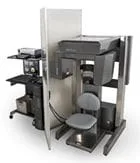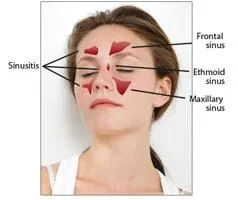Rhinology/Sinus Disease
Nasal Obstruction
Coblation Turbinates
Turbinate coblation is an effective treatment that painlessly removes the tissue that causes nasal obstruction with radiofrequency technology. Patients who suffer from nasal obstruction have enlarged turbinates that affect their breathing and block the nasal passage. This procedure can also be used to treat chronic nasal congestion, facial pressure and nasal drainage.
During the procedure, local anesthetic will be applied to the nose to minimize any discomfort. A special wand is inserted into each turbinate to carefully remove excess tissue, instantaneously reducing the size of the turbinate. The wand then applies coblation therapy to the area to create a channel within the turbinate.
After the coblation procedure, the channel in the turbinate will shrink, relieving nasal obstruction and restoring normal breathing.
Septoplasty
Septoplasty is a surgical procedure to correct defects or deformities of the septum. The nasal septum is the separation between the two nostrils. In adults, it is composed of both cartilage and bone. The nasal septum has three functions: support the nose, regulate air flow, and support the mucous membranes of the nose. A number of medical conditions may indicate a need for the procedure including nasal air passage obstruction, a deviated septum, tumors, chronic and uncontrolled nosebleeds, or the presence of polyps, etc. Additionally, a septoplasty may be performed in conjunction with a rhinoplasty in order to ensure that the reshaping of the nose does not result in a reduction of the amount of breathing space.
Patients who receive septoplasty can usually return home the same day or in the morning after surgery. Risks or complications are relatively rare. Recovery symptoms may include bleeding, swelling, bruising, or discoloration.
In Office Sinus CT Scanner


Click here to learn more about the In Office CT Scanner.
Sinusitis
Sinusitis is a condition that refers to an inflammation of the lining within the paranasal sinuses. Sinusitis can be classified by location:
-

- frontal, which causes pain or pressure above and behind the eyes;
- ethmoid, which causes pain or pressure between or behind the eyes; and
- sphenoid, which causes pain or pressure behind the eyes.
Sinusitis can also be classified by duration: acute lasts for four weeks or less, subacute lasts four to twelve weeks, chronic lasts more than twelve weeks, and recurrent, which consists of several acute attacks within a year.
Most acute cases of sinusitis are caused by an inflammation of the sinuses that eventually lead to a bacterial infection. With chronic sinusitis, the membranes of both the paranasal sinuses and the nose are thickened because they are constantly inflamed, possibly due to allergies, nasal polyps, or asthma.
Nasal Polyps
Nasal polyps are benign growths that develop within the lining of the nasal passages or sinuses. If large enough, these growths may block the passages and cause breathing difficulties, sinus infections or other complications.
Nasal polyps are most common in adults, especially those with asthma or allergies. Children with cystic fibrosis are also at a higher risk of developing nasal polyps. They often develop in occurrence with respiratory diseases such as sinusitis and allergic rhinitis or immunodeficiency conditions.
Most patients with nasal polyps may experience nasal congestion, as well as runny nose, headache, facial pain, loss of smell or taste and sinus pressure. Some patients may not have any symptoms if the polyp is small.
Treatment for nasal polyps is often provided through medications that can reduce the size of the polyp or even eliminate it. Medication may be in the form of pills, nasal sprays or allergy shots. Surgery may be required to remove the polyp if medication is unsuccessful, and may include a polypectomy or endoscopic sinus surgery to either suction out the polyp or remove it carefully with tiny instruments.
Sinus Tumors
Sinus tumors may develop in any of the four sinus cavities as a result of abnormal cell growth in the area. While the specific cause is unknown, tumors tend to develop in patients with chronic sinusitis or those who have been exposed to certain substances. Most of these tumors are benign, but may cause symptoms such as nasal obstruction, facial pain, blurred vision and more, which can indicate a cancerous tumor.
Cancerous tumors that develop in the sinus cavities are usually squamous cell carcinomas, which tend to be slow-growing and do not usually spread to other areas, although they still require thorough treatment.
Treatment for sinus tumors depends on the type, size and severity of the lesion, but often involves surgical resection of the tumor, which can be performed using endoscopic or open surgical techniques. Surgery may be combined with chemotherapy or radiation therapy for cancerous tumors. Small, benign tumors may not require any treatment other than observation to detect growth or any other abnormalities, as long as the tumor does not interfere with the patient’s everyday life.
